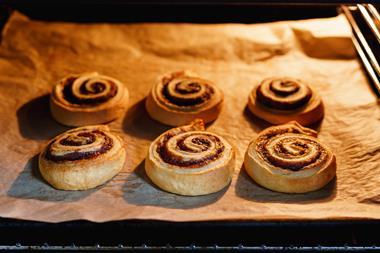I’m currently in the TV-free depths of the Brecon Beacon and could only watch The Great British Bake Off (GBBO) by leaning out of the window. Bandwidth is scarce here - I might as well be on Mont Blanc.
But this is where Ian found himself in the quarter final’s first challenge - not physically of course, but he decided to fill one of his puff pastry cream horns with chestnut purée, the main ingredient of the famous dessert.
The big debate was what method puff pastry to use - full puff or rough puff. ‘Frozen’ would probably be most people’s answer. A well-made rough puff is as good as a poorly made full puff pastry, as Flora confirmed, since she rolled her layers too thin and the pastry ended up with a sweet pastry texture. Nadiya used rough puff and got a cracker of a result.
Ian tried a duo of chocolate and plain puff pastry; it sounded like a nice idea, but winding two types of pastry onto the small cone mould turned out to be quite unstable. Neither pastry baked properly, but his flavours were good and even got him Mary’s wink!
I would like to point Ian in the direction of the Russian Bretzel, a recipe that uses puff pastry as well as a chocolate sweet pastry to fashion a twisted two-tone pretzel.
It’s marvellous with a cup of coffee. I’m salivating at the thought of one.
Mary and Paul wanted a fully filled cream horn, but some fillings were too thick to reach the very tip. And they are right: who wants to be left with a dry puff pastry cone on their plate? Mind you, I avoid this kind of disappointment by eating the tip first and pigging out on the full creamy bit at the end.
Schadenfreude is the German word for taking delight in someone’s misfortune and this, I’m afraid, applied to Paul’s attempt to make a Genoese sponge for the Mokatines technical challenge. Since there were was no baking method, he ended up with pancakes rather than sponge. Genoese is flesh and blood for Continental bakers, where it is the base for all manner of cream-filled layer cakes or the base for a simple strawberry fruit tart.
What really struck me was that all the bakers cut the sponge into squares, then filled each individually. Not one of them decided to fill the whole sheet first, set it, then cut it. Besides being more efficient, it would have given the Mokatines a much better shape. Nadiya is my kind of girl; she said she had seen the recipe in Marry Berry’s book, but felt it was too complicated to bake. However, she did have a sense of what was needed and came tops in the technical challenge.
History
There was time for a clip on the history of macarons. Les Soeurs Macarons is the famous bakery in France that still bakes them to the original recipe. Unlike in 1793, they are no longer hand-piped but extruded and furthermore made with some equipment that is so specialised and so secret it was covered with pristine white sheets to stop 12 million pairs of eyes from spying.
This week’s showstopper was Religieuse a l’ancienne. An éclair tower with the capability of staying erect for 2 hours and we all know how difficult that is! You either need the dry air of France or an air-conditioned hotel, but doing it in the relative humidity of a tent was never going to be easy. Sure enough Paul bolted but Nadiya produced a bubble gum flavoured flash bulb moment that won her star baker.


























No comments yet